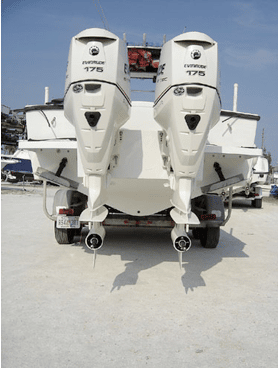
Outboard Repower
With the season drawing to a close in the northern areas of the country, you may be giving thought to purchasing a new outboard. Perhaps you want more horsepower or maybe acquired the itch to own the latest and greatest in technology. Of course, a past summer of engine problems could be the deciding factor.
Repowering is not just the act of bolting a new outboard on the back then heading out for the water. There is more required to do the job correctly and safely. Some outboard manufacturers do not allow motors sold “in-the-box.” Dealers are required to rig and test run the engine before sending in a signed pre-delivery form for warranty registration.
Support items must be inspected, repaired, or replaced in addition to installing a new engine. Some of these components if not in good shape could affect the running, the warranty, or your safety. For example electrical components, controls, oil tanks, fuel system, and steering may be showing their age and need attention or replacement. Each system should be inspected by a professional to determine its condition and suitability with your new motor
- Not only is the proper transom height important, but any softness from rotted wood has to be corrected before engine installation. You may even consider the addition of a motor bracket for your transom. To avoid possible legal issues do not overpower your rig.
- Steering systems are very important as a safety concern. It may be wise to upgrade to a hydraulic system if a push-pull cable steering is inadequate or worn.
- The electrical wiring harnesses if not replaced require inspection plus the battery must be the correct type with adequate capacity for the new outboard. Professionals recommend updating the old electrical items as there may be hidden damage and/or corrosion inside the wires or connectors causing intermittent problems.
- Gauges and warning horn should be compatible with the new motor. To go high-tech, check out the latest in digital display offerings and the networking possibilities with your electronics.
- Control boxes and cables are subject to wear and professional inspection is recommended if reused. Look into the “fly-by-wire” electronic shift and throttle controls that are for available for many models. These are great for multi-engine rigs with their push-button engine synchronization feature.
- If an adequate amount of clean gasoline is not delivered to the engine, it may run poorly, lack power, and the motor may suffer piston damage. Use the latest in USCG approved fuel lines of the correct size with the A1-15 or B1-15 rating imprinted on them for your safety.
- The final step in a re-powering to determine the correct propeller for your new outboard. This must be done on the water with a normal load of fuel, gear, and passengers on board.
With everything now installed and tested, enjoy your newly powered rig with friends and family knowing that the boat is reliable and correctly rigged.
SUGGESTED READING









